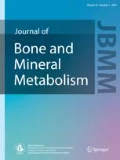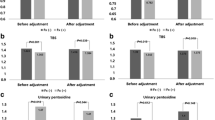Abstract
To evaluate whether or not the urinary pentosidine level has clinical value in the assessment of the osteoporotic fracture risk, a novel ELISA for pentosidine was used in clinical samples. This study employed a cross-sectional design to analyze a subset of postmenopausal women in the Nagano Cohort Study. A total of 517 urine samples were analyzed using an ELISA system, which can measure urinary pentosidine without hydrolysis. Patients were asked about their history of non-vertebral osteoporotic fracture and the prevalence of vertebral fracture was semi-quantitatively assessed on X-ray films. A 10-year increase in age was related to a 1.09-fold increase in the urinary pentosidine level (95% CI 1.05–1.13, P < 0.001), prevalent fracture (+) was related to a 1.10-fold increase in the urinary pentosidine level (95% CI 1.03–1.18, P = 0.006). Patients with prevalent fracture who had a normal bone mineral density (BMD) showed higher pentosidine levels (median 34.3 pM/mg Cr) than patients with a low BMD without fracture (median 31.4 pM/mg Cr). A multivariable logistic regression analysis revealed that urinary pentosidine was significantly associated with the prevalence of fracture after adjustment for known risk factors for fracture (odds ratio 1.92, 95% CI 1.09–3.37, P = 0.023). The present results indicated a significant association between urinary pentosidine and fracture after adjustment for age and BMD, suggesting that urinary pentosidine may be useful for assessing the fracture risk in postmenopausal women.


Similar content being viewed by others
Change history
19 November 2019
In the original publication of the article, the following sentence under the abstract section was published incorrectly as “A multivariable logistic regression analysis revealed that urinary pentosidine was significantly associated with the prevalence of fracture after adjustment for known risk factors for fracture (odds ratio 1.92, 95% CI 1.09–3.37, <Emphasis Type="Italic">P </Emphasis>= 0.023).”
19 November 2019
In the original publication of the article, the following sentence under the abstract section was published incorrectly as ���A multivariable logistic regression analysis revealed that urinary pentosidine was significantly associated with the prevalence of fracture after adjustment for known risk factors for fracture (odds ratio 1.92, 95% CI 1.09���3.37, P���=���0.023).���
References
Saito M, Marumo K (2010) Collagencross-links as a determinant bone quality: a possible explanation for bone fragility in ageing, osteoporosis, and diabetes mellitus. Osteoporosis Int 21:195–214
Saito M, Kida Y, Nishizawa T, Arakawa S, Okabe H, Seki A, Marumo K (2015) Effects of 18-month treatment with bazedoxifene on enzyme immature and mature cross-links and non-enzymatic advanced glycation end products, mineralization, and trabecular microarchitecture of vertebra in ovariectomized monkeys. Bone 81:573–580
Saito M, Grynpas MD, Burr DB, Allen MR, Smith SY, Doyle N, Amizuka N, Hasegawa T, Kida Y, Marumo K, Saito H (2015) Treatment with eldecalcitol positively affects mineralization, microdamage, and collagen crosslinks in primate bone. Bone 73:8–15
Shiraki M, Kuroda T, Tanaka S, Saito M, Fukunaga M, Nakamura T (2008) Nonenzymatic collagen cross-links induced by glycoxidation (pentosidine) predicts vertebral fractures. J Bone Miner Metab 26:93–100
Tamaki J, Kouda K, Fujita Y, Iki M, Yura A, Miura M, Sato Y, Okamoto N, Kurumatani N (2018) Ratio of endogenous secretory receptor for advanced glycation end products to pentosidine predicts fractures in Men. J Clin Endocrinol Metab 103:85–94
Tanaka S, Kuroda T, Saito M, Shiraki M (2011) Urinary pentosidine improves risk classification using fracture risk assessment tools for postmenopausal women. J Bone Miner Res 26:2778–2784
Schwartz AV, Garnero P, Hillier TA, Sellmeyer DE, Strotmeyer ES, Feingold KR, Resnik HE, Tylavsky FA, Black DM, Cummings SR, Harris TB, Bauer DC, For the health, aging, and body composition study (2009) Pentosidine and increased fracture risk in older adults with type 2 diabetes. J Clin Endocr Metab 94:2380–2386
Yamamoto M, Yamaguchi T, Yamauchi M, Yano S, Sugimoto T (2008) Serum pentosidine levels are positively associated with the presence of vertebral fractures in postmenopausal women with type 2 diabetes. J Clin Endocrinol Metab 93:1013–1019
Urano T, Shiraki M, Ouchi Y, Inoue S (2012) Association of circulating sclerostin levels with fat mass and metabolic disease- related markers in Japanese postmenopausal women. J Clin Endocrinol Metab 97:E1473–E1477
Kuroda T, Uenishi K, Ohta H, Shiraki M (2018) Multiple vitamin deficiencies additively increase the fracture risk of incident fractures in Japanese postmenopausal women. Osteoporos Int. https://doi.org/10.1007/s00198-018-4784-2
Genant HK, Wu CY, van Kuijk C et al (1993) Vertebral fracture assessment using a semiquantitative technique. J Bone Miner Res 8:1137–1148
Soen S, Fukunaga M, Sugimoto T, Sone T, Fujiwara S, Endo N, Gorai I, Shiraki M, Hagino H, Hosoi T, Ohta H, Yoneda T, Tomomitsu T, Japanese Society for Bone and Mineral Research and Japan Osteoporosis Society Joint Review Committee for the Revision of the Diagnostic Criteria for Primary Osteoporosis (2013) Diagnostic criteria for primary osteoporosis: year 2012 revision. J Bone Miner Metab 31:247–257
NIH Consensus Development Panel on Osteoporosis Prevention, Diagnosis, and Therapy (2001) Osteoporosis prevention, diagnosis, and therapy. JAMA 2001(285):785–795
Wang X, Shen X, Li X, Agrawal CM (2002) Age-related changes in collagen network and toughness of bone. Bone 31:1–7
Vashishth D, Gibson GJ, Khoury JI, Schaffler MB, Kimura J, Fyhrie DP (2001) Influence of nonenzymatic glycation on biochemical properties of cortical bone. Bone 28:195–201
Uzawa K, Grezesik WJ, Nishimura T, Kuznetssov SA, Robey PG, Brenner DA, Yamauchi M (1999) Differential expression of human lysyl hydroxylase genes, lysyl hydroxylation, and cross-linking of type I collagen during osteoblastic differentiation in vitro. J Bone Miner Res 14:1270–1280
Sell DR, Monnier VM (1989) Structure elucidation of a senescence crosslink from human extracellular matrix: implication of pentose in aging process. J Biol Chem 264:21597–21602
Izuhara Y, Miyata T, Ueda Y, Suzuki D, Asahi K, Inagi R, Sakai H, Kurokawa K (1999) A sensitive and specific ELISA for plasma pentosidine (in eng). Nephrol Dial Transplant 14:576–580
Taneda S, Monnier VM (1994) ELISA of pentosidine, an advanced glycation end product, in biological specimens (in eng). Clin Chem 40:1766–1773
Sanaka T, Funaki T, Tanaka T, Hoshi S, Niwayama J, Taitoh T, Nishimura H, Higuchi C (2002) Plasma pentosidine levels measured by a newly developed method using ELISA in patients with chronic renal failure (in eng). Nephron 91:64–73. https://doi.org/10.1159/000057606
Nakano M, Kubota M, Owada S, Nagai R (2013) The pentosidine concentration in human blood specimens is affected by heating. Amino Acids 44:1451–1456. https://doi.org/10.1007/s00726-011-1180-z
Acknowledgements
The authors would like to thank the patients who agreed to participate in the present project. The authors would also like to thank Dr. Brian Quinn for editing the English of this paper.
Author information
Authors and Affiliations
Corresponding author
Ethics declarations
Conflict of interest
MS received consultant fee from Teijin pharma and Asahi Kasei Pharma, a manufacturer of drugs to treat osteoporosis. SK is an employee of SB Bioscience Co., Ltd. TI, ST, and MiS declare no conflicts of interest in association with the present study.
Additional information
Publisher's Note
Springer Nature remains neutral with regard to jurisdictional claims in published maps and institutional affiliations.
About this article
Cite this article
Shiraki, M., Kashiwabara, S., Imai, T. et al. The association of urinary pentosidine levels with the prevalence of osteoporotic fractures in postmenopausal women. J Bone Miner Metab 37, 1067–1074 (2019). https://doi.org/10.1007/s00774-019-01017-9
Received:
Accepted:
Published:
Issue Date:
DOI: https://doi.org/10.1007/s00774-019-01017-9




